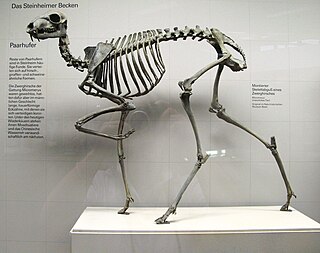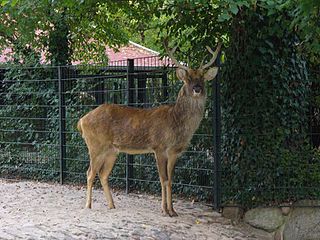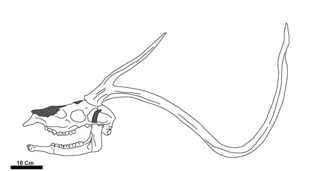
A deer or true deer is a hoofed ruminant ungulate of the family Cervidae. Cervidae is divided into subfamilies Cervinae and Capreolinae. Male deer of almost all species, as well as female reindeer, grow and shed new antlers each year. These antlers are bony extensions of the skull and are often used for combat between males.

Moschidae is a family of pecoran even-toed ungulates, containing the musk deer (Moschus) and its extinct relatives. They are characterized by long 'saber teeth' instead of horns, antlers or ossicones, modest size and a lack of facial glands. While various Oligocene and Miocene pecorans were previously assigned to this family, recent studies find that most should be assigned to their own clades, although further research would need to confirm these traits. As a result, Micromeryx, Hispanomeryx, and Moschus are the only undisputed moschid members, making them known from at least 18 Ma. The group was abundant across Eurasia and North America during the Miocene, but afterwards declined to only the extant genus Moschus by the early Pleistocene.

The Irish elk, also called the giant deer or Irish deer, is an extinct species of deer in the genus Megaloceros and is one of the largest deer that ever lived. Its range extended across Eurasia during the Pleistocene, from Ireland to Lake Baikal in Siberia. The most recent remains of the species have been radiocarbon dated to about 7,700 years ago in western Russia. Its antlers, which can span 3.5 metres (11 ft) across are the largest known of any deer. It is not closely related to either living species called the elk, with it being widely agreed that its closest living relatives are fallow deer (Dama).

Megaloceros is an extinct genus of deer whose members lived throughout Eurasia from the Pleistocene to the early Holocene. The type and only undisputed member of the genus, Megaloceros giganteus, vernacularly known as the "Irish elk" or "giant deer", is also the best known. Fallow deer are thought to be their closest living relatives. Megaloceros has been suggested to be closely related to other genera of "giant deer", like the East Asian genus Sinomegaceros, and the European Praemegaceros.

The Antilocapridae are a family of ruminant artiodactyls endemic to North America. Their closest extant relatives are the giraffids. Only one species, the pronghorn, is living today; all other members of the family are extinct. The living pronghorn is a small ruminant mammal resembling an antelope.

Eucladoceros is an extinct genus of large deer whose fossils have been discovered across Eurasia, from Europe to China, spanning from the Late Pliocene-Early Pleistocene. It is noted for its unusual comb-like or branching antlers.

Candiacervus is an extinct genus of deer native to Pleistocene Crete. Due to a lack of other herbivores, the genus underwent an adaptive radiation, filling niches occupied by other taxa on the mainland. Due to the small size of Crete, some species underwent insular dwarfism, the smallest species, C. ropalophorus, stood about 40 centimetres (16 in) at the shoulders when fully grown, while other species were relatively large and comparable in size to mainland deer species. Some species are noted for their peculiar, elongate club-shaped antlers, though other species have more normal antlers.

The Philippine deer, also known as the Philippine sambar or Philippine brown deer, is a vulnerable deer species endemic to the Philippines. It was first described from introduced populations in the Mariana Islands, hence the specific name.
Six species of deer are living wild in Great Britain: Scottish red deer, roe deer, fallow deer, sika deer, Reeves's muntjac, and Chinese water deer. Of those, Scottish red and roe deer are native and have lived in the isles throughout the Holocene. Fallow deer have been reintroduced twice, by the Romans and the Normans, after dying out in the last ice age. The other three are escaped or released alien species. Moose were also formerly native to Britain, before dying out during the mid-Holocene, over 5,000 years ago. The comparably sized Irish elk, which had the largest antlers of any deer was formerly also native to Britain, until becoming regionally extinct some 12,000 years ago.

Odocoileus lucasi, known commonly as the American mountain deer, is an extinct species of North American deer.

The Late Pleistocene to the beginning of the Holocene saw the extinction of the majority of the world's megafauna, which resulted in a collapse in faunal density and diversity across the globe. The extinctions during the Late Pleistocene are differentiated from previous extinctions by its extreme size bias towards large animals, and widespread absence of ecological succession to replace these extinct megafaunal species, and the regime shift of previously established faunal relationships and habitats as a consequence. The timing and severity of the extinctions varied by region and are thought to have been driven by varying combinations of human and climatic factors. Human impact on megafauna populations is thought to have been driven by hunting ("overkill"), as well as possibly environmental alteration. The relative importance of human vs climatic factors in the extinctions has been the subject of long-running controversy.
Antifer is an extinct genus of large herbivorous deer belonging to the tribe Odocoileini native to South America during the Pleistocene, becoming extinct around 12,000 years ago. It was one of the largest South American deer genera, with an estimated body mass of up to 200 kilograms (440 lb), comparable to red deer, considerably exceeding the marsh deer, the largest living South American deer species in size. The genus has large antlers that could reach length of over 60 centimetres (24 in).

Rucervus is a genus of deer from India, Nepal, Indochina, and the Chinese island of Hainan. The only extant representatives, the barasingha or swamp deer and Eld's deer, are threatened by habitat loss and hunting; another species, Schomburgk’s deer, went extinct in 1938. Deer species found within the genus Rucervus are characterized by a specific antler structure, where the basal ramification is often supplemented with an additional small prong, and the middle tine is never present. The crown tines are inserted on the posterior side of the beam and may be bifurcated or fused into a small palmation.

Fallow deer is the common name for species of deer in the genus Dama of subfamily Cervinae.

Cervalces latifrons, the broad-fronted moose, or the giant moose was a giant species of deer that inhabited Europe and Asia during the Pleistocene epoch. It is thought to be the ancestor of the modern moose, as well as the extinct North American Cervalces scotti. It was considerably larger than living moose, placing it as one of the largest deer to have ever lived.

Praemegaceros is an extinct genus of deer, known from the Pleistocene and Holocene of Western Eurasia. Praemegaceros is considered to be a genus of "giant deer", with many species having an estimated body mass of around 400 kilograms (880 lb), considerably larger than most living deer.
Morenelaphus is an extinct genus of capreoline deer that lived in South America during the Pleistocene, ranging from the Pampas to southern Bolivia and Northeast Brazil. There is only a single recognised species, Morenelaphus brachyceros. It was a large deer, with some specimens estimated to exceed 200 kilograms in body mass. The antlers were over 70 cm in length, and are superficially similar those of deer belonging to the subfamily Cervinae, like red deer. Fossils of the genus have been recovered from the Agua Blanca, Fortín Tres Pozos and Luján Formations of Argentina, the Ñuapua Formation of Bolivia, Santa Vitória do Palmar in southern Brazil, Paraguay and the Sopas Formation of Uruguay.

Megaceroides algericus is an extinct species of deer known from the Late Pleistocene to the Holocene of North Africa. It is one of only two species of deer known to have been native to the African continent, alongside the Barbary stag, a subspecies of red deer. It is considered to be closely related to the giant deer species of Eurasia.

Sinomegaceros is an extinct genus of deer known from the Late Pliocene/Early Pleistocene to Late Pleistocene of Central and East Asia. It is considered to be part of the group of "giant deer", with a close relationship to Megaloceros. Many members of the genus are noted for their distinctive palmate antler brow tines.

Haploidoceros is an extinct genus of deer that lived in Europe during the Pleistocene. It contains a single species, Haploidoceros mediterraneus. It had a distribution limited to southern France and the Iberian Peninsula.

















